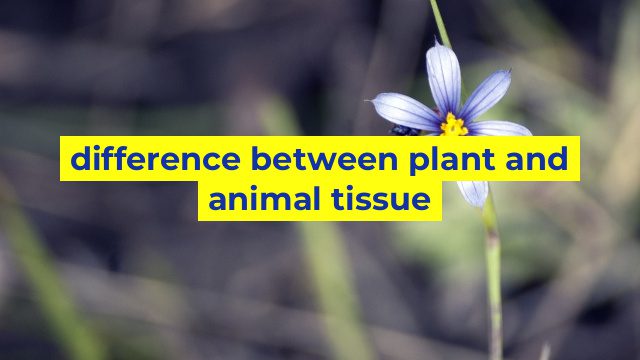Difference between Plant and Animal Tissue
Introduction
Plants and animals are two main types of multi-cellular organisms that inhabit the earth. They are different in terms of their anatomy and physiology. The tissues in plants and animals are diverse and perform different functions. Plant and animal tissues are differentiated by the presence of cell walls, organelles, and other structural and functional characteristics.
Cell Structure
Plant and animal tissues are differentiated by their cell structure. Cells in animal tissues are generally smaller and lack cell walls, whereas plant tissues are made up of cells that have cell walls, which provide rigidity and support. Animal cells are more flexible than plant cells due to the absence of cell walls. Plant cells also have chloroplasts, which enable them to produce their food through photosynthesis.
Composition
Both plant and animal tissues are made up of cells, but they differ in the type and quantity of cells. Plants have several types of cells that perform different functions, such as the xylem and phloem cells, which are responsible for transporting water and nutrients. In contrast, animal tissues are more complex, with several types of cells that form organs and perform specific functions, such as muscle cells, nerve cells, and blood cells.
Growth and Development
Plant and animal tissues differ in their growth and development. Plant tissues have the ability to regenerate and regenerate new tissues, which helps them adapt to changing environmental conditions. For instance, plants can heal themselves after being injured or attacked by insects. In contrast, animal tissues have limited regenerative capacity, and damage to organ tissue may lead to permanent damage.
Conclusion
In conclusion, plant and animal tissues have several differences in terms of their cell structure, composition, growth, and development. The presence of cell walls, chloroplasts, and other structural components differentiate plant tissues from animal tissues. Both types of tissues have advantages and disadvantages, and understanding these differences can help scientists develop new therapies and treatments for various diseases. Additionally, studying plant and animal tissues can help researchers better understand the evolution of life on earth.
Table difference between plant and animal tissue
| Plant Tissue | Animal Tissue |
|---|---|
| Plant cells have a cell wall made of cellulose. | Animal cells do not have a cell wall. |
| Plant cells have chloroplasts for photosynthesis. | Animal cells do not have chloroplasts as they do not perform photosynthesis. |
| Plant cells may have large central vacuoles for storage. | Animal cells have smaller vacuoles or no vacuoles at all. |
| Plant cells can divide throughout their life and may differentiate into new cell types. | Animal cells can only divide a certain amount of times and differentiate into specific cell types. |
| Plant cells can absorb water and nutrients from the soil through their roots. | Animal cells do not have roots and obtain nutrients through their diet. |

